Examining Amazon's Strategies for Communicating User Privacy Data
VerifiedAdded on 2023/06/12
|6
|1550
|442
Report
AI Summary
This report examines how Amazon communicates its data privacy policies and practices to users. It discusses the increasing importance of data privacy in a globalized, technologically advanced world, highlighting the collection, storage, and dissemination of personal information. The report contrasts US privacy standards, which rely on sector-specific laws, with the need for a comprehensive federal data protection resolution. It details the types of data Amazon collects, including user-provided information, interaction data, and data from other sources, and how this data is used for order fulfillment, service improvement, and legal compliance. The report emphasizes that while Amazon shares data with third-party service providers and for business transactions, it does not sell customer information. It concludes by advocating for a federal data protection law in the US to provide clarity and promote trust in the digital marketplace. Desklib provides past papers and solved assignments for students.

A research question and rationale
Paraphrase This Document
Need a fresh take? Get an instant paraphrase of this document with our AI Paraphraser
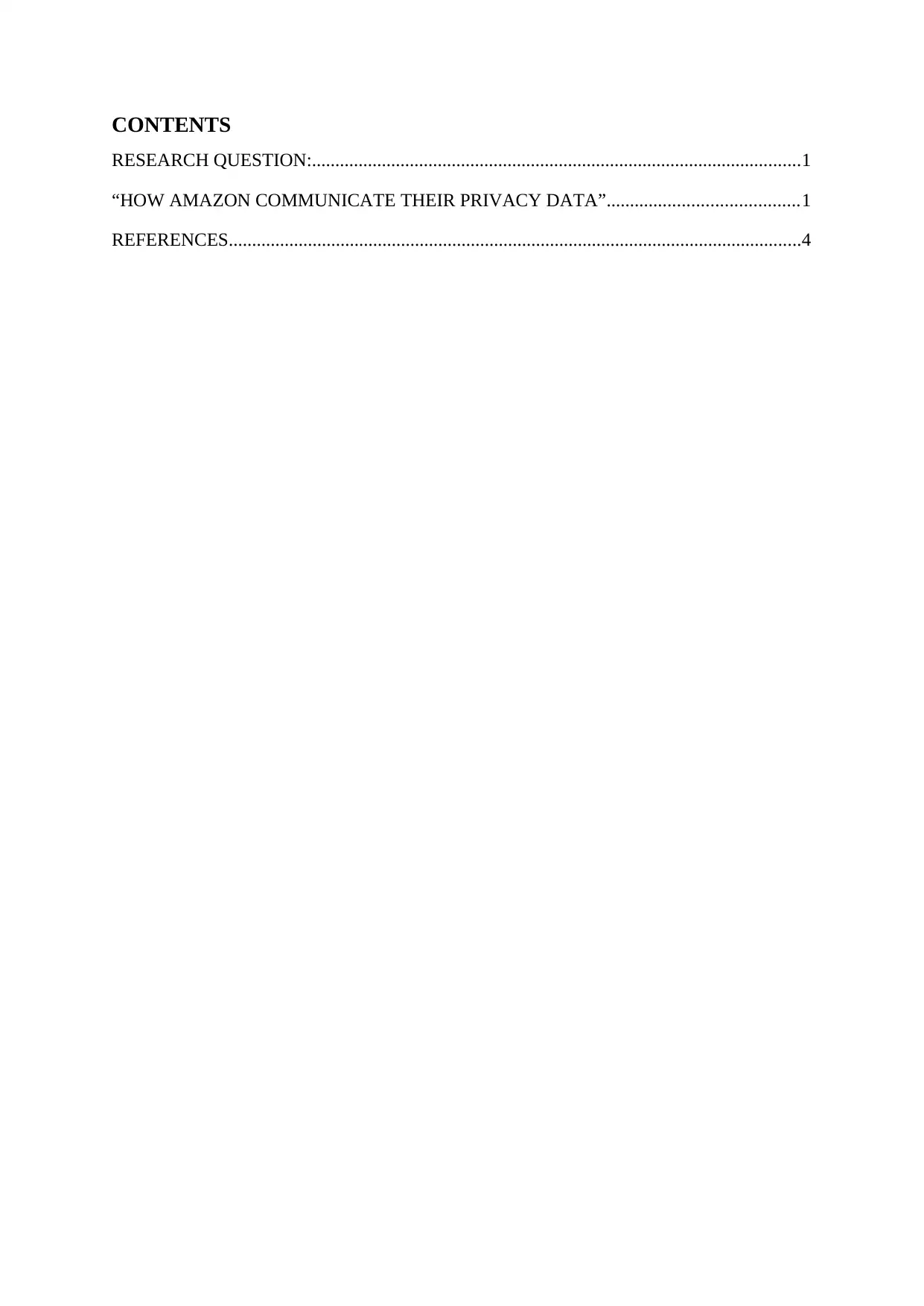
CONTENTS
RESEARCH QUESTION:.........................................................................................................1
“HOW AMAZON COMMUNICATE THEIR PRIVACY DATA”.........................................1
REFERENCES...........................................................................................................................4
RESEARCH QUESTION:.........................................................................................................1
“HOW AMAZON COMMUNICATE THEIR PRIVACY DATA”.........................................1
REFERENCES...........................................................................................................................4
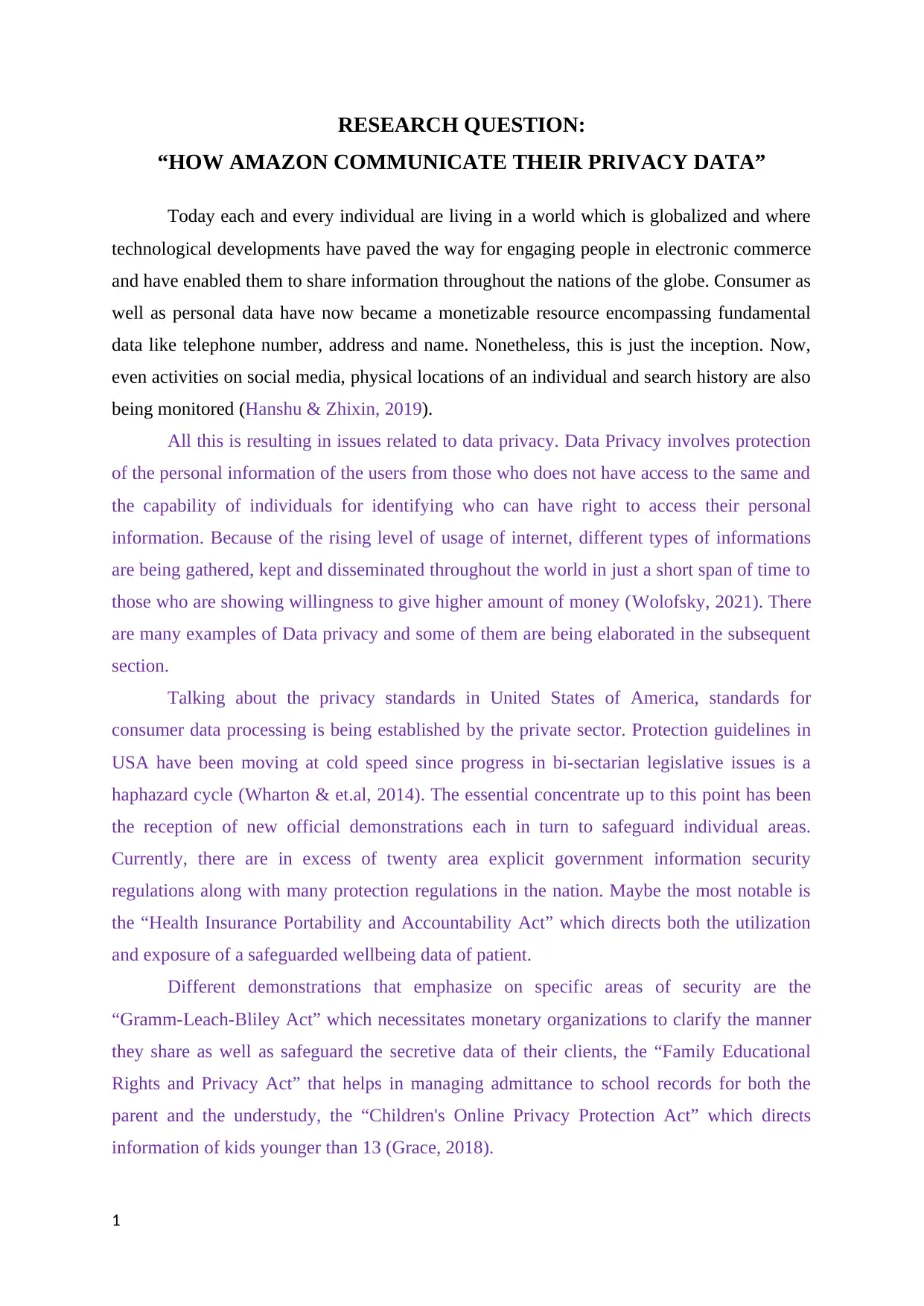
RESEARCH QUESTION:
“HOW AMAZON COMMUNICATE THEIR PRIVACY DATA”
Today each and every individual are living in a world which is globalized and where
technological developments have paved the way for engaging people in electronic commerce
and have enabled them to share information throughout the nations of the globe. Consumer as
well as personal data have now became a monetizable resource encompassing fundamental
data like telephone number, address and name. Nonetheless, this is just the inception. Now,
even activities on social media, physical locations of an individual and search history are also
being monitored (Hanshu & Zhixin, 2019).
All this is resulting in issues related to data privacy. Data Privacy involves protection
of the personal information of the users from those who does not have access to the same and
the capability of individuals for identifying who can have right to access their personal
information. Because of the rising level of usage of internet, different types of informations
are being gathered, kept and disseminated throughout the world in just a short span of time to
those who are showing willingness to give higher amount of money (Wolofsky, 2021). There
are many examples of Data privacy and some of them are being elaborated in the subsequent
section.
Talking about the privacy standards in United States of America, standards for
consumer data processing is being established by the private sector. Protection guidelines in
USA have been moving at cold speed since progress in bi-sectarian legislative issues is a
haphazard cycle (Wharton & et.al, 2014). The essential concentrate up to this point has been
the reception of new official demonstrations each in turn to safeguard individual areas.
Currently, there are in excess of twenty area explicit government information security
regulations along with many protection regulations in the nation. Maybe the most notable is
the “Health Insurance Portability and Accountability Act” which directs both the utilization
and exposure of a safeguarded wellbeing data of patient.
Different demonstrations that emphasize on specific areas of security are the
“Gramm-Leach-Bliley Act” which necessitates monetary organizations to clarify the manner
they share as well as safeguard the secretive data of their clients, the “Family Educational
Rights and Privacy Act” that helps in managing admittance to school records for both the
parent and the understudy, the “Children's Online Privacy Protection Act” which directs
information of kids younger than 13 (Grace, 2018).
1
“HOW AMAZON COMMUNICATE THEIR PRIVACY DATA”
Today each and every individual are living in a world which is globalized and where
technological developments have paved the way for engaging people in electronic commerce
and have enabled them to share information throughout the nations of the globe. Consumer as
well as personal data have now became a monetizable resource encompassing fundamental
data like telephone number, address and name. Nonetheless, this is just the inception. Now,
even activities on social media, physical locations of an individual and search history are also
being monitored (Hanshu & Zhixin, 2019).
All this is resulting in issues related to data privacy. Data Privacy involves protection
of the personal information of the users from those who does not have access to the same and
the capability of individuals for identifying who can have right to access their personal
information. Because of the rising level of usage of internet, different types of informations
are being gathered, kept and disseminated throughout the world in just a short span of time to
those who are showing willingness to give higher amount of money (Wolofsky, 2021). There
are many examples of Data privacy and some of them are being elaborated in the subsequent
section.
Talking about the privacy standards in United States of America, standards for
consumer data processing is being established by the private sector. Protection guidelines in
USA have been moving at cold speed since progress in bi-sectarian legislative issues is a
haphazard cycle (Wharton & et.al, 2014). The essential concentrate up to this point has been
the reception of new official demonstrations each in turn to safeguard individual areas.
Currently, there are in excess of twenty area explicit government information security
regulations along with many protection regulations in the nation. Maybe the most notable is
the “Health Insurance Portability and Accountability Act” which directs both the utilization
and exposure of a safeguarded wellbeing data of patient.
Different demonstrations that emphasize on specific areas of security are the
“Gramm-Leach-Bliley Act” which necessitates monetary organizations to clarify the manner
they share as well as safeguard the secretive data of their clients, the “Family Educational
Rights and Privacy Act” that helps in managing admittance to school records for both the
parent and the understudy, the “Children's Online Privacy Protection Act” which directs
information of kids younger than 13 (Grace, 2018).
1
⊘ This is a preview!⊘
Do you want full access?
Subscribe today to unlock all pages.

Trusted by 1+ million students worldwide
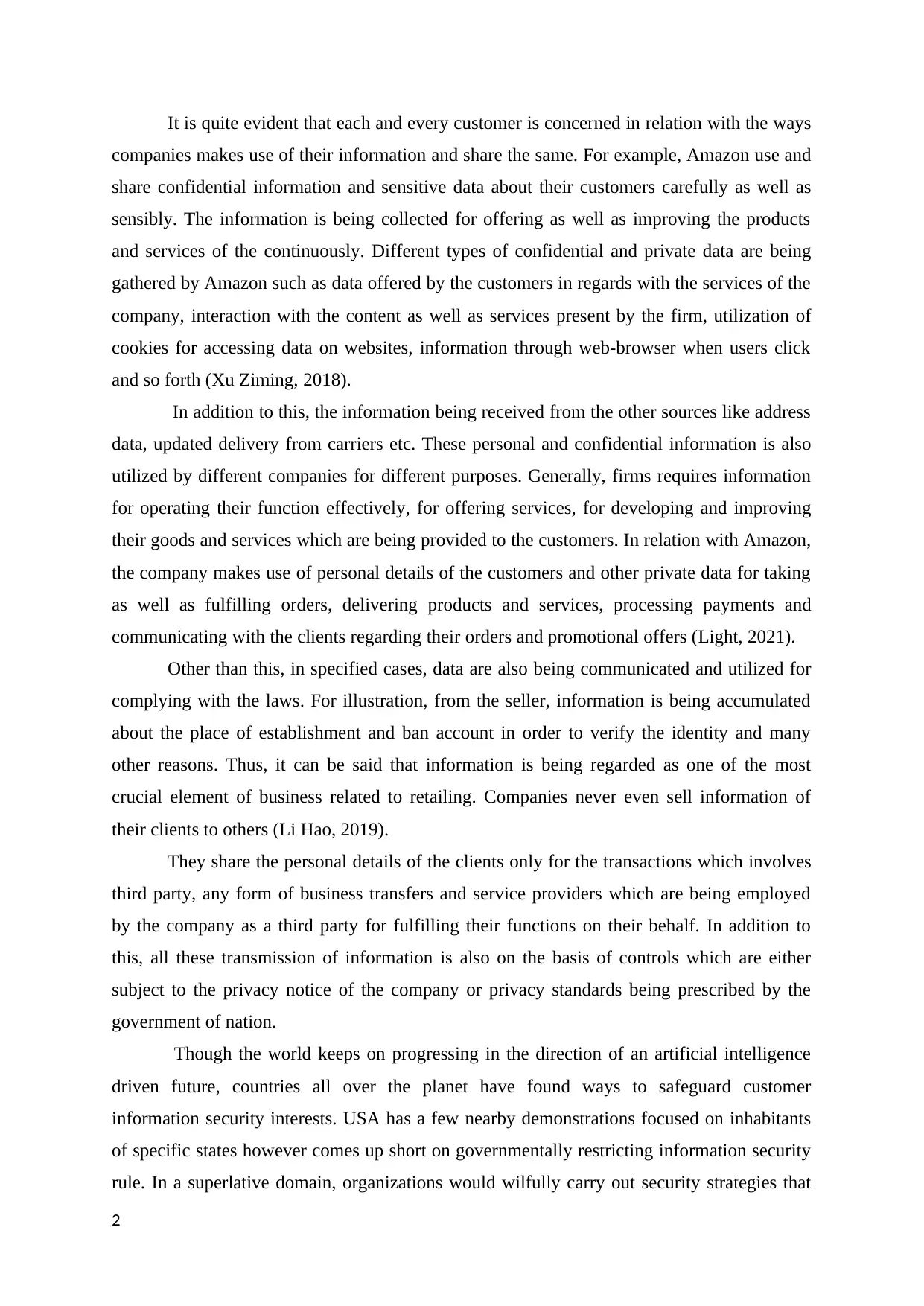
It is quite evident that each and every customer is concerned in relation with the ways
companies makes use of their information and share the same. For example, Amazon use and
share confidential information and sensitive data about their customers carefully as well as
sensibly. The information is being collected for offering as well as improving the products
and services of the continuously. Different types of confidential and private data are being
gathered by Amazon such as data offered by the customers in regards with the services of the
company, interaction with the content as well as services present by the firm, utilization of
cookies for accessing data on websites, information through web-browser when users click
and so forth (Xu Ziming, 2018).
In addition to this, the information being received from the other sources like address
data, updated delivery from carriers etc. These personal and confidential information is also
utilized by different companies for different purposes. Generally, firms requires information
for operating their function effectively, for offering services, for developing and improving
their goods and services which are being provided to the customers. In relation with Amazon,
the company makes use of personal details of the customers and other private data for taking
as well as fulfilling orders, delivering products and services, processing payments and
communicating with the clients regarding their orders and promotional offers (Light, 2021).
Other than this, in specified cases, data are also being communicated and utilized for
complying with the laws. For illustration, from the seller, information is being accumulated
about the place of establishment and ban account in order to verify the identity and many
other reasons. Thus, it can be said that information is being regarded as one of the most
crucial element of business related to retailing. Companies never even sell information of
their clients to others (Li Hao, 2019).
They share the personal details of the clients only for the transactions which involves
third party, any form of business transfers and service providers which are being employed
by the company as a third party for fulfilling their functions on their behalf. In addition to
this, all these transmission of information is also on the basis of controls which are either
subject to the privacy notice of the company or privacy standards being prescribed by the
government of nation.
Though the world keeps on progressing in the direction of an artificial intelligence
driven future, countries all over the planet have found ways to safeguard customer
information security interests. USA has a few nearby demonstrations focused on inhabitants
of specific states however comes up short on governmentally restricting information security
rule. In a superlative domain, organizations would wilfully carry out security strategies that
2
companies makes use of their information and share the same. For example, Amazon use and
share confidential information and sensitive data about their customers carefully as well as
sensibly. The information is being collected for offering as well as improving the products
and services of the continuously. Different types of confidential and private data are being
gathered by Amazon such as data offered by the customers in regards with the services of the
company, interaction with the content as well as services present by the firm, utilization of
cookies for accessing data on websites, information through web-browser when users click
and so forth (Xu Ziming, 2018).
In addition to this, the information being received from the other sources like address
data, updated delivery from carriers etc. These personal and confidential information is also
utilized by different companies for different purposes. Generally, firms requires information
for operating their function effectively, for offering services, for developing and improving
their goods and services which are being provided to the customers. In relation with Amazon,
the company makes use of personal details of the customers and other private data for taking
as well as fulfilling orders, delivering products and services, processing payments and
communicating with the clients regarding their orders and promotional offers (Light, 2021).
Other than this, in specified cases, data are also being communicated and utilized for
complying with the laws. For illustration, from the seller, information is being accumulated
about the place of establishment and ban account in order to verify the identity and many
other reasons. Thus, it can be said that information is being regarded as one of the most
crucial element of business related to retailing. Companies never even sell information of
their clients to others (Li Hao, 2019).
They share the personal details of the clients only for the transactions which involves
third party, any form of business transfers and service providers which are being employed
by the company as a third party for fulfilling their functions on their behalf. In addition to
this, all these transmission of information is also on the basis of controls which are either
subject to the privacy notice of the company or privacy standards being prescribed by the
government of nation.
Though the world keeps on progressing in the direction of an artificial intelligence
driven future, countries all over the planet have found ways to safeguard customer
information security interests. USA has a few nearby demonstrations focused on inhabitants
of specific states however comes up short on governmentally restricting information security
rule. In a superlative domain, organizations would wilfully carry out security strategies that
2
Paraphrase This Document
Need a fresh take? Get an instant paraphrase of this document with our AI Paraphraser
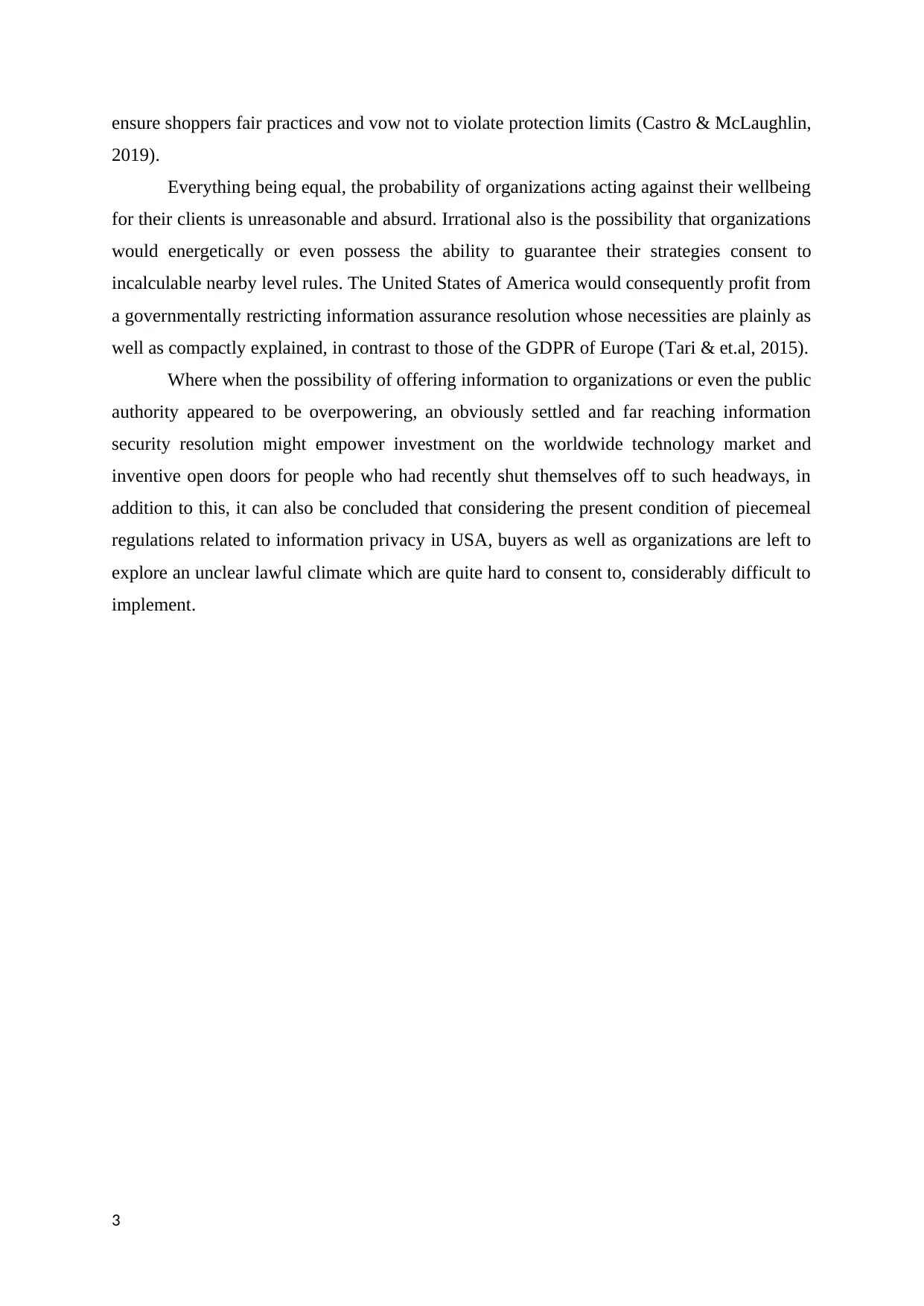
ensure shoppers fair practices and vow not to violate protection limits (Castro & McLaughlin,
2019).
Everything being equal, the probability of organizations acting against their wellbeing
for their clients is unreasonable and absurd. Irrational also is the possibility that organizations
would energetically or even possess the ability to guarantee their strategies consent to
incalculable nearby level rules. The United States of America would consequently profit from
a governmentally restricting information assurance resolution whose necessities are plainly as
well as compactly explained, in contrast to those of the GDPR of Europe (Tari & et.al, 2015).
Where when the possibility of offering information to organizations or even the public
authority appeared to be overpowering, an obviously settled and far reaching information
security resolution might empower investment on the worldwide technology market and
inventive open doors for people who had recently shut themselves off to such headways, in
addition to this, it can also be concluded that considering the present condition of piecemeal
regulations related to information privacy in USA, buyers as well as organizations are left to
explore an unclear lawful climate which are quite hard to consent to, considerably difficult to
implement.
3
2019).
Everything being equal, the probability of organizations acting against their wellbeing
for their clients is unreasonable and absurd. Irrational also is the possibility that organizations
would energetically or even possess the ability to guarantee their strategies consent to
incalculable nearby level rules. The United States of America would consequently profit from
a governmentally restricting information assurance resolution whose necessities are plainly as
well as compactly explained, in contrast to those of the GDPR of Europe (Tari & et.al, 2015).
Where when the possibility of offering information to organizations or even the public
authority appeared to be overpowering, an obviously settled and far reaching information
security resolution might empower investment on the worldwide technology market and
inventive open doors for people who had recently shut themselves off to such headways, in
addition to this, it can also be concluded that considering the present condition of piecemeal
regulations related to information privacy in USA, buyers as well as organizations are left to
explore an unclear lawful climate which are quite hard to consent to, considerably difficult to
implement.
3
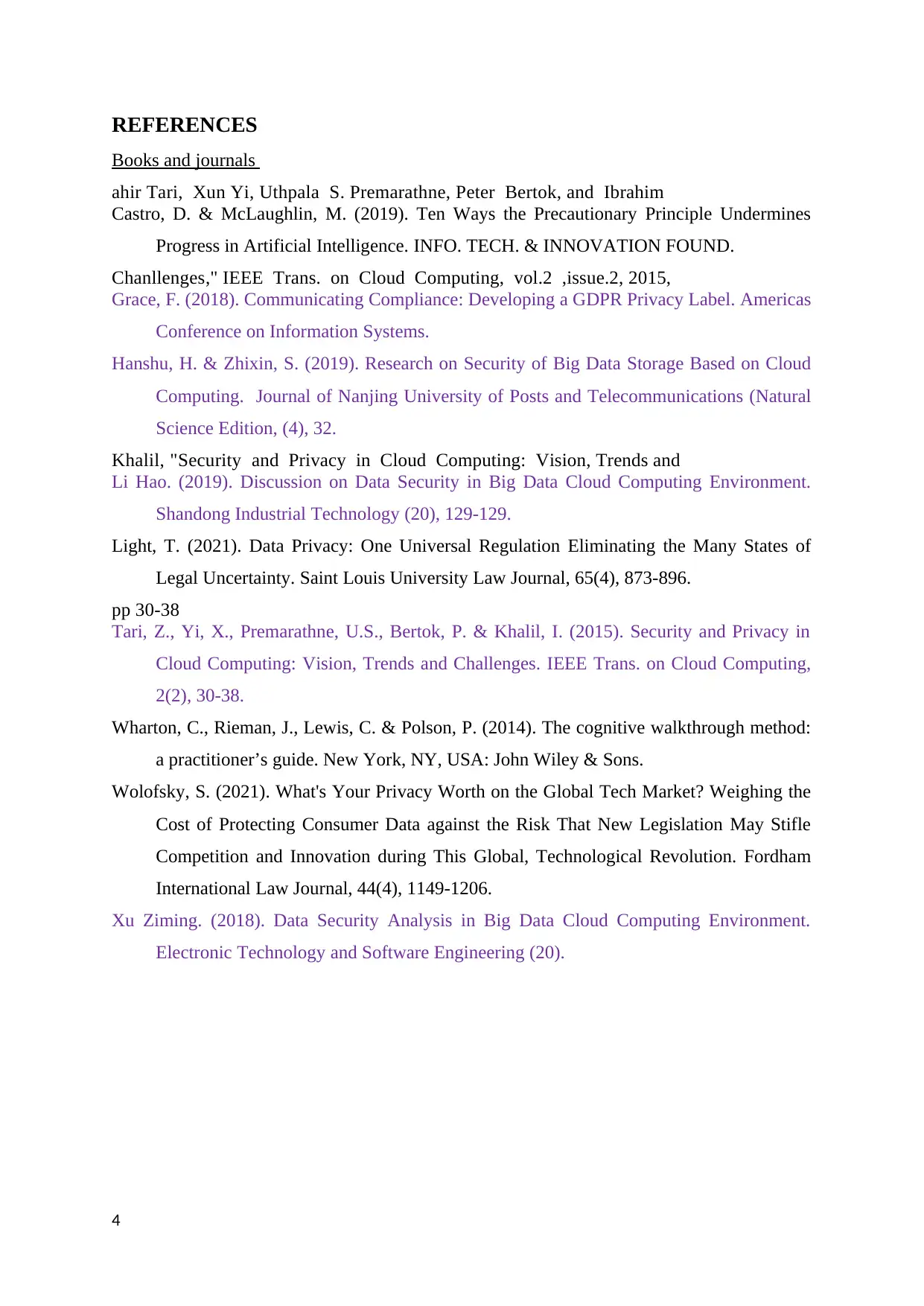
REFERENCES
Books and journals
ahir Tari, Xun Yi, Uthpala S. Premarathne, Peter Bertok, and Ibrahim
Castro, D. & McLaughlin, M. (2019). Ten Ways the Precautionary Principle Undermines
Progress in Artificial Intelligence. INFO. TECH. & INNOVATION FOUND.
Chanllenges," IEEE Trans. on Cloud Computing, vol.2 ,issue.2, 2015,
Grace, F. (2018). Communicating Compliance: Developing a GDPR Privacy Label. Americas
Conference on Information Systems.
Hanshu, H. & Zhixin, S. (2019). Research on Security of Big Data Storage Based on Cloud
Computing. Journal of Nanjing University of Posts and Telecommunications (Natural
Science Edition, (4), 32.
Khalil, "Security and Privacy in Cloud Computing: Vision, Trends and
Li Hao. (2019). Discussion on Data Security in Big Data Cloud Computing Environment.
Shandong Industrial Technology (20), 129-129.
Light, T. (2021). Data Privacy: One Universal Regulation Eliminating the Many States of
Legal Uncertainty. Saint Louis University Law Journal, 65(4), 873-896.
pp 30-38
Tari, Z., Yi, X., Premarathne, U.S., Bertok, P. & Khalil, I. (2015). Security and Privacy in
Cloud Computing: Vision, Trends and Challenges. IEEE Trans. on Cloud Computing,
2(2), 30-38.
Wharton, C., Rieman, J., Lewis, C. & Polson, P. (2014). The cognitive walkthrough method:
a practitioner’s guide. New York, NY, USA: John Wiley & Sons.
Wolofsky, S. (2021). What's Your Privacy Worth on the Global Tech Market? Weighing the
Cost of Protecting Consumer Data against the Risk That New Legislation May Stifle
Competition and Innovation during This Global, Technological Revolution. Fordham
International Law Journal, 44(4), 1149-1206.
Xu Ziming. (2018). Data Security Analysis in Big Data Cloud Computing Environment.
Electronic Technology and Software Engineering (20).
4
Books and journals
ahir Tari, Xun Yi, Uthpala S. Premarathne, Peter Bertok, and Ibrahim
Castro, D. & McLaughlin, M. (2019). Ten Ways the Precautionary Principle Undermines
Progress in Artificial Intelligence. INFO. TECH. & INNOVATION FOUND.
Chanllenges," IEEE Trans. on Cloud Computing, vol.2 ,issue.2, 2015,
Grace, F. (2018). Communicating Compliance: Developing a GDPR Privacy Label. Americas
Conference on Information Systems.
Hanshu, H. & Zhixin, S. (2019). Research on Security of Big Data Storage Based on Cloud
Computing. Journal of Nanjing University of Posts and Telecommunications (Natural
Science Edition, (4), 32.
Khalil, "Security and Privacy in Cloud Computing: Vision, Trends and
Li Hao. (2019). Discussion on Data Security in Big Data Cloud Computing Environment.
Shandong Industrial Technology (20), 129-129.
Light, T. (2021). Data Privacy: One Universal Regulation Eliminating the Many States of
Legal Uncertainty. Saint Louis University Law Journal, 65(4), 873-896.
pp 30-38
Tari, Z., Yi, X., Premarathne, U.S., Bertok, P. & Khalil, I. (2015). Security and Privacy in
Cloud Computing: Vision, Trends and Challenges. IEEE Trans. on Cloud Computing,
2(2), 30-38.
Wharton, C., Rieman, J., Lewis, C. & Polson, P. (2014). The cognitive walkthrough method:
a practitioner’s guide. New York, NY, USA: John Wiley & Sons.
Wolofsky, S. (2021). What's Your Privacy Worth on the Global Tech Market? Weighing the
Cost of Protecting Consumer Data against the Risk That New Legislation May Stifle
Competition and Innovation during This Global, Technological Revolution. Fordham
International Law Journal, 44(4), 1149-1206.
Xu Ziming. (2018). Data Security Analysis in Big Data Cloud Computing Environment.
Electronic Technology and Software Engineering (20).
4
⊘ This is a preview!⊘
Do you want full access?
Subscribe today to unlock all pages.

Trusted by 1+ million students worldwide
1 out of 6
Related Documents
Your All-in-One AI-Powered Toolkit for Academic Success.
+13062052269
info@desklib.com
Available 24*7 on WhatsApp / Email
![[object Object]](/_next/static/media/star-bottom.7253800d.svg)
Unlock your academic potential
Copyright © 2020–2025 A2Z Services. All Rights Reserved. Developed and managed by ZUCOL.





